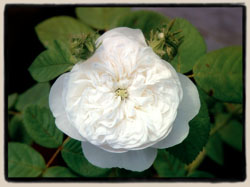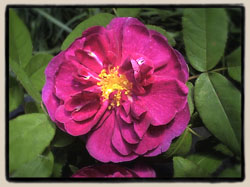 |
|
Albas |
From
Brent Dickerson: "Damask Roses are supposed to be from a hybridization
between R. gallica and R. phoenicia which occurred in Asia Minor and
became distributed throughout Syria and the Near East and Middle East
generally. The Crusaders--according to tradition--brought it back
to Europe from Damascus (hence the name) in 1254. However, there is
a most daunting and seemingly impenetrable fog around R. damascena.
References can be found to "the common Damask" as late as the 1820's,
and yet what an author is referring to by this term remains elusive.
It indeed frequently seems that "the Common Damask" is rather a Damask
Perpetual! Worse, cultivars which we today consider as defining the
group--`Leda', perhaps, and 'Mme. Hardy'--seem to have been hybrids.
'Celsiana', a most beautiful and popular rose, is possibly "typical"
Damask; and yet, even it has its mystery (current research seems to
indicate that the "pre-1750" date usually put forward is whimsical).
Even 'York and Lancaster', frequently considered to be a sport of
the original (red?) Damask, is supposed by one authority to be an
Alba on the basis of a sporting back to something like the Alba 'Semiplena'!
The cultivar used for the rose oil industry in Bulgaria, `Trigintipetala',
supposedly a long-ago import from Turkey, is perhaps dependably R.
damascena . . . . That said, characteristics associated with our concept
of what a Damask should look like are: upright frequently arching
canes, grayish-green somewhat rugose somewhat hirsute leaves, large
fragrant blossoms in few-flowered clusters, delicate in appearance,
and ranging in color from white to deep pink depending on the cultivar." This group also includes the Damask Perpetuals, which I have grouped with Damasks for convenience: "This group was the only repeat-blooming one known to the Europeans until the advent of the China roses. It had indeed been known seemingly in at least one variety ('Bifera') since Roman times. Another cultivar ('Tous-les-Mois') appeared in the 17th century, and breeding work in earnest began on them in the 1810's. Vibert and his successors in his firm had a very great interest in this group, and introduced by far the greatest number of them, the last one ('Rembrandt') of their long-pursued line coming out in 1883. They typically have stocky, healthy, decorative bushes, with the often exquisitely double, fragrant blossoms nestling in the leaves. There are several races of them: the Biferas, with tall, arching growth; the Portlands, showing Gallica influence; the Tous-les-Mois, the typical sort, bushy and compact with tight blossoms; and the Trianons, tall, vigorous, Hybrid-Perpetual like growth with clusters of flowers. The colors range from white through all the pinks to deepest red." Original photographs and site content © Paul Barden 1996-2006. All Rights Reserved. |
|


